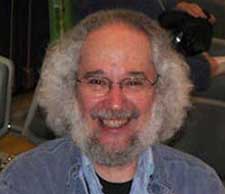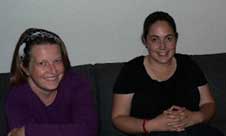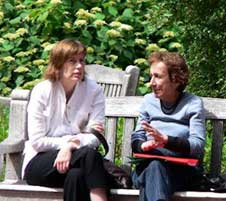The Perfect Parent Organization for PER
Edward F. Redish and David Brooks
Working Group Members: Rebecca Lindell, Leslie Atkins, Eleanor Sayre, Sebastien Cormier, Tanya Antimirova, Michael Loverude, Donald Mountcastle, Edward F. “Joe” Redish, David Brookes, Cornelius Bennhold, Paula Heron
1. Introduction
 Our group had the task of identifying the perfect parent organization for the field of physics education research (PER). Our group decided that, in order to identify a parent organization (PO), we needed to first answer the question: What do we as a community need or want from a professional organization? Having answered this question, we examined how well we thought our needs were currently being met by existing organizations such as the American Association of Physics Teachers (AAPT) and the American Physical Society (APS) and the ways in which a parent organization (PO) might be able to meet those needs in the future. Finally we asked: What should our relationships be to existing professional organizations, or should we create our own? This report will endeavor to present as much of a consensus viewpoint of our group as possible.
Our group had the task of identifying the perfect parent organization for the field of physics education research (PER). Our group decided that, in order to identify a parent organization (PO), we needed to first answer the question: What do we as a community need or want from a professional organization? Having answered this question, we examined how well we thought our needs were currently being met by existing organizations such as the American Association of Physics Teachers (AAPT) and the American Physical Society (APS) and the ways in which a parent organization (PO) might be able to meet those needs in the future. Finally we asked: What should our relationships be to existing professional organizations, or should we create our own? This report will endeavor to present as much of a consensus viewpoint of our group as possible.
2. Our community needs and how well they are currently served
Our group identified a number of professional activities that we engage in as a research community. We then identified and prioritized ways in which a parent organization would be able to support those activities. We debated how well we felt each of these activities was currently being supported by existing organizations such as the AAPT and APS. We believe that our parent organization should be involved in helping to facilitate, support, provide venues and environments to support the following needs and activities:
2.1 Interacting with each other as a research community
There are a number of ways in which a PO could support and encourage interactions with each other. We prioritize these activities and venues as follows:
- Priority 1: PER publications and PER conferences. With regards to publication venues, we feel that the current diversity of organizations (AAPT, APS, AIP, ComPADRE) is a fairly good one. Having all these different publication venues seems better than “putting all our eggs in one basket.” With regards to conferences, we feel that we have enough conference time, but would like more control over how our conferences are run. Two possible models are: 1) Conduct our own conferences within bigger (AAPT or APS) conferences, similar to the APS March meeting, in which different subfields of physics run sessions fairly autonomously. 2) Hold our own separate conference, similar to the Foundations and Frontiers in PER conference but without a size restriction. Our PO would provide organizational support for such a conference.
- Priority 2: A clearinghouse for employment opportunities, information sharing and collaborative activities; venues for matching potential collaborators; recruitment of faculty and graduate students into our field, and professional development. Many of these needs are currently met in some form. While there are many events that promote collaboration and professional development at conferences, online venues for collaboration or job advertisements are insufficiently centralized. Ideas include a) a single PER job website in Wiki format (already initiated by Sebastien Cormier at http://perjobs.blogspot.com/), and b) a “professional facebook” to facilitate collaboration between researchers at different universities and promote matching of researchers with common interests. Ideally, all these venues would be run from a centralized server, overseen and financed by our PO.
- Priority 3: Interactions in multiple modes and venues, databases and information collection, and recognition of achievement within the field. Currently comPADRE provides some of these services. We envision a greatly expanded system including: 1) concept inventories (with password protection), 2) institutional review board information and sample responses and forms, 3) curricular materials, 4) research data in many different forms, 5) information on journals for promotion packets (impact factors, acceptance rates, etc.), 6) a description of what PER is with a link to the APS statement, 7) a “canon” collection (a list of seminal PER papers), 8) a PER Wiki, and so on. With regards to recognition of achievement, we have APS fellowships and AAPT awards but feel we need fellowships for a larger collection of contributors.
2.2 Interacting with and disseminating to our “consumers”
 This includes the following activities: Informing potential consumers about PER and its value, publishing overviews and reviews of PER, disseminating instructional materials, and reaching new faculty. Our goal should be to inform physics faculty on the purpose and classic results of PER, and to help them understand both the practical value of PER for their instruction and its value as an intellectual discipline.
This includes the following activities: Informing potential consumers about PER and its value, publishing overviews and reviews of PER, disseminating instructional materials, and reaching new faculty. Our goal should be to inform physics faculty on the purpose and classic results of PER, and to help them understand both the practical value of PER for their instruction and its value as an intellectual discipline.
We currently have workshops and conferences and “evangelizers.” We would like to expand these resources to include: a) a speaker list and b) a well-marketed journal that reaches a large fraction of faculty who are specifically interested in improving their teaching. Some ideas that emerged were: a) short summaries of research, b) a collector journal, and c) distribution of information about what is happening in PER to highly read venues (for example, articles in the Chronicle for Higher Education or Science). In summary, our PO would encourage and help PER folk create these products.
2.3 Interacting with related disciplines
We would like a professional organization to facilitate sharing of information with related disciplines including meetings and even summaries of significant research results. Our parent organization would facilitate open bi-directional lines of communication to education, cognitive and learning sciences, and other STEM education research fields.
2.4 Public relations
Our PO would be involved in lobbying with legislature, lobbying funding agencies, advisory panels, and public advocacy.
3. Our relationships with existing professional organizations
In reviewing the activities listed above that we would like our parent organization to facilitate and support, we realize that many of our activities are at least partially supported by either the AAPT, the APS, a combination of the two, or by the alliance of organizations that support comPADRE. We note a number of successes of satisfying our needs in these communities, such as the creation of the PER topical group and the PR-STPER journal under the APS.
 In identifying our parent organization, we realize that we have strong representation in the AAPT. In the APS, we are a much smaller part, but are a part of the largest subunit: the Forum on Education. In this Forum, we are well represented in the leadership. In summary, we are respected as an important and vital part of both of these organizations. Many of us are conflicted about throwing our lot in with one organization or the other: To become a recognized part of the physics community, we need to be a part of the APS, yet much of our dissemination audience resides in the AAPT and in science education organizations. Choosing one organization over the other as our parent organization may involve sacrificing part of our community mission. In our view, we have identified unmet or inadequately met needs and should, at present, push to get those needs satisfied within both the AAPT and APS.
In identifying our parent organization, we realize that we have strong representation in the AAPT. In the APS, we are a much smaller part, but are a part of the largest subunit: the Forum on Education. In this Forum, we are well represented in the leadership. In summary, we are respected as an important and vital part of both of these organizations. Many of us are conflicted about throwing our lot in with one organization or the other: To become a recognized part of the physics community, we need to be a part of the APS, yet much of our dissemination audience resides in the AAPT and in science education organizations. Choosing one organization over the other as our parent organization may involve sacrificing part of our community mission. In our view, we have identified unmet or inadequately met needs and should, at present, push to get those needs satisfied within both the AAPT and APS.
We call on those who have ideas for specific mechanisms to communicate their ideas to the leadership of the PER Topical Group (in the AAPT) and the Forum on Education (in the APS), and be willing to do the work to help get them started. We hope that, over time, individual start-up efforts (e.g., a PER job rumors blog) will be incorporated into more organized institutional structures.
Edward F. Redish is a Professor of Physics at the University of Maryland in College Park.
David Brookes is a post-doctoral research associate at the University of Illinois at Urbana-Champaign.
